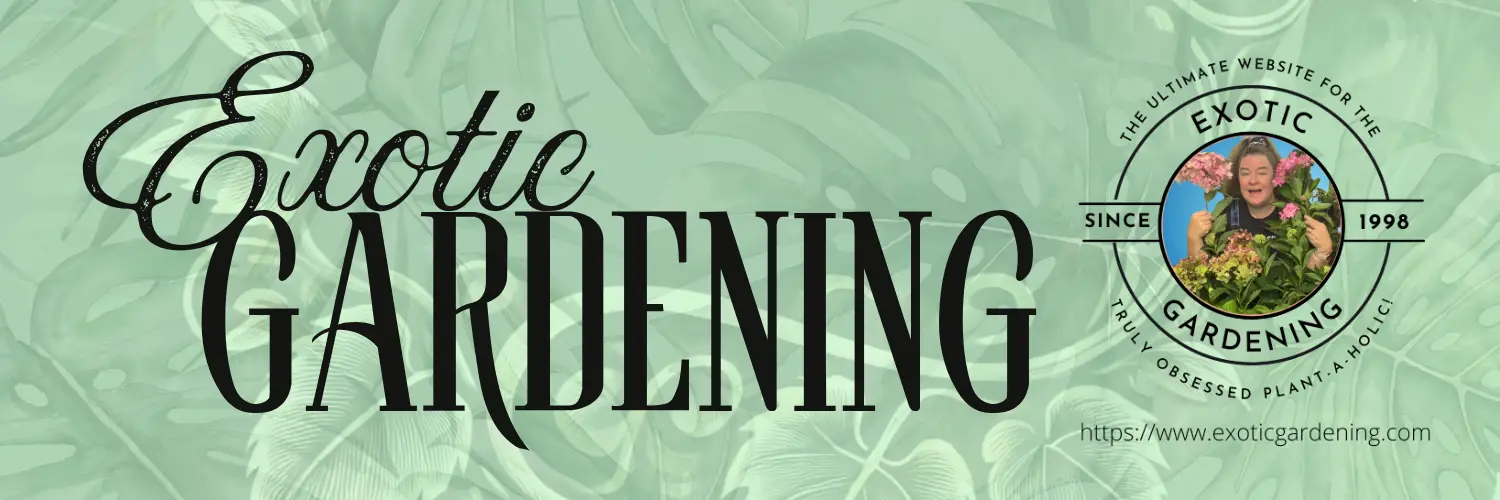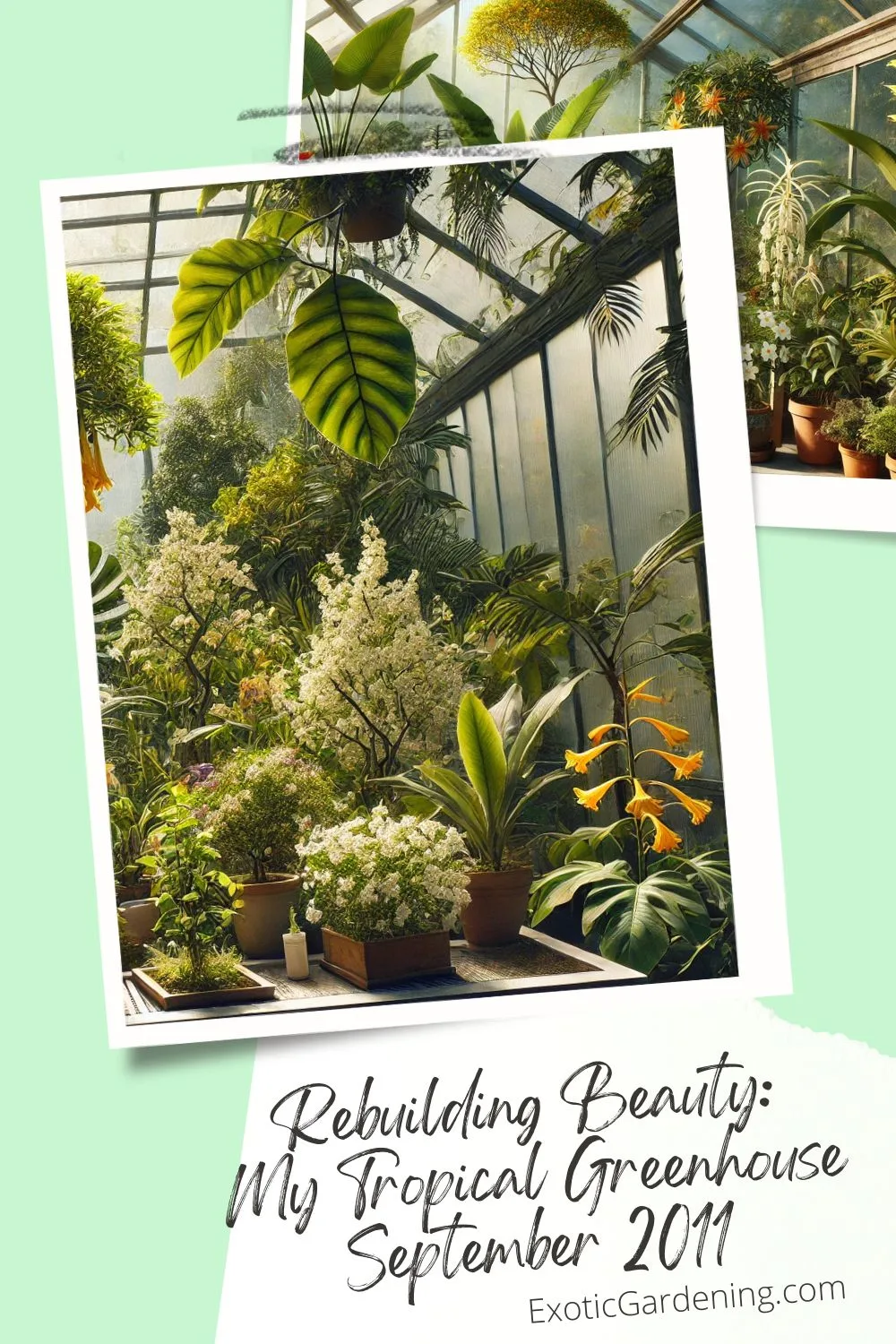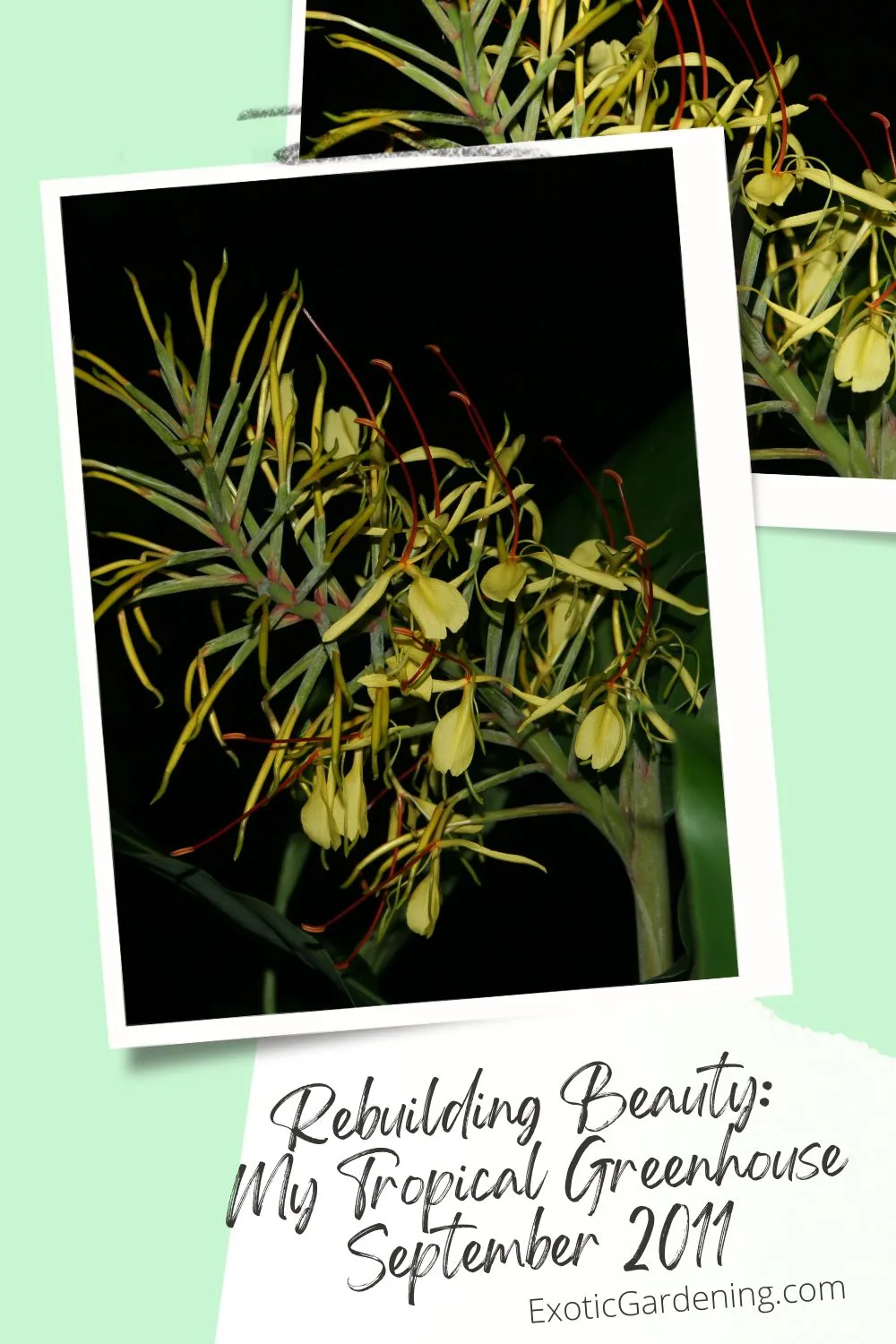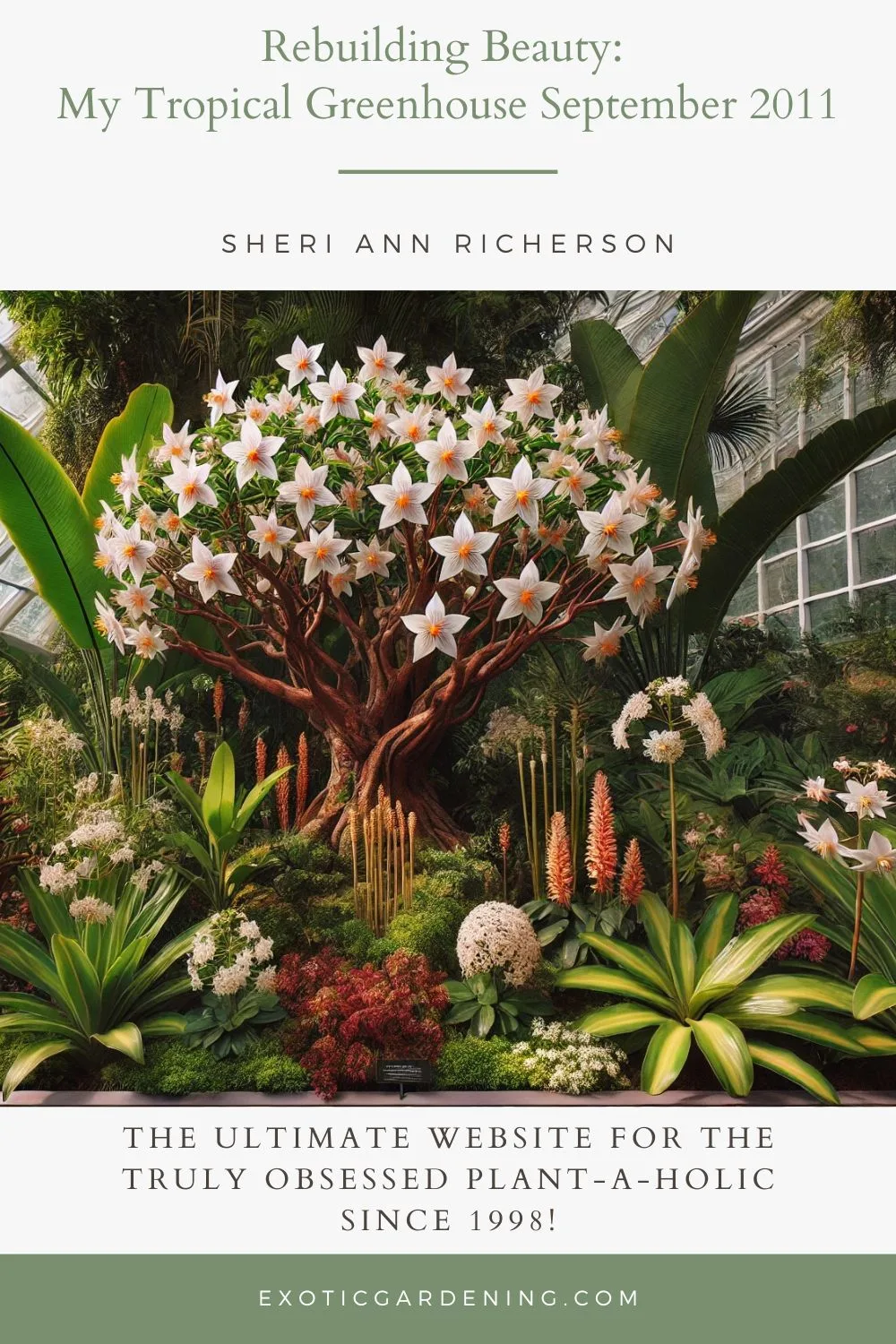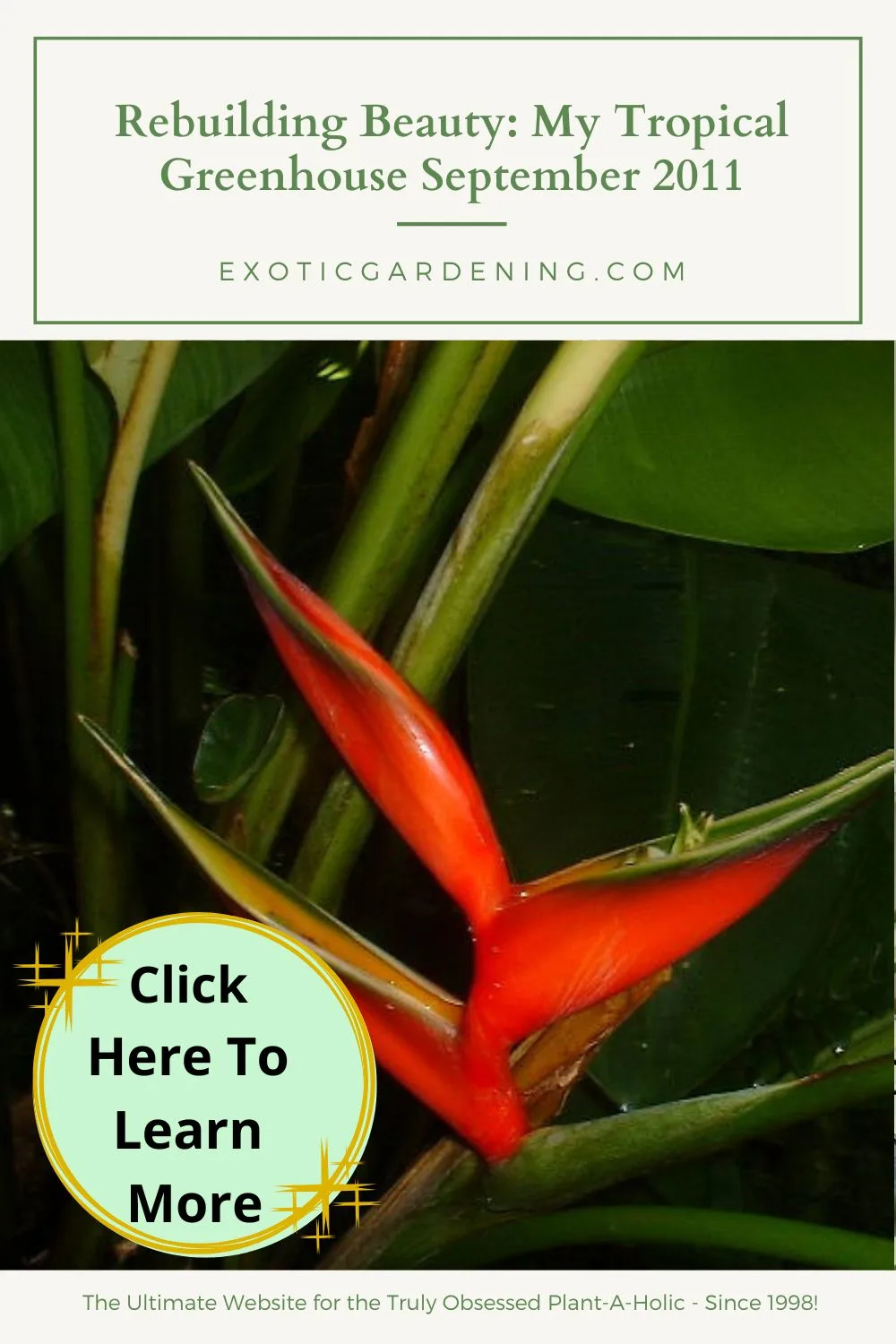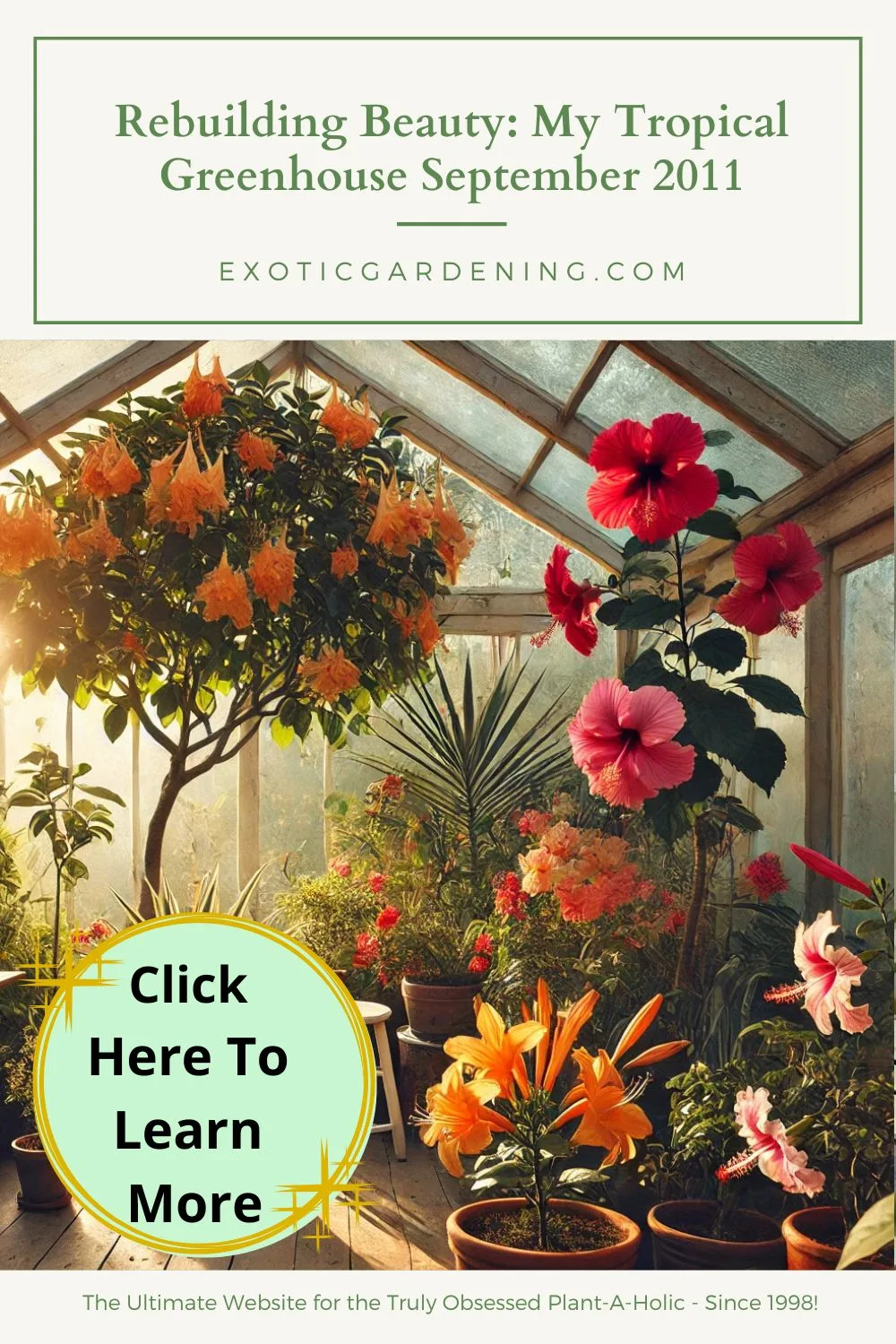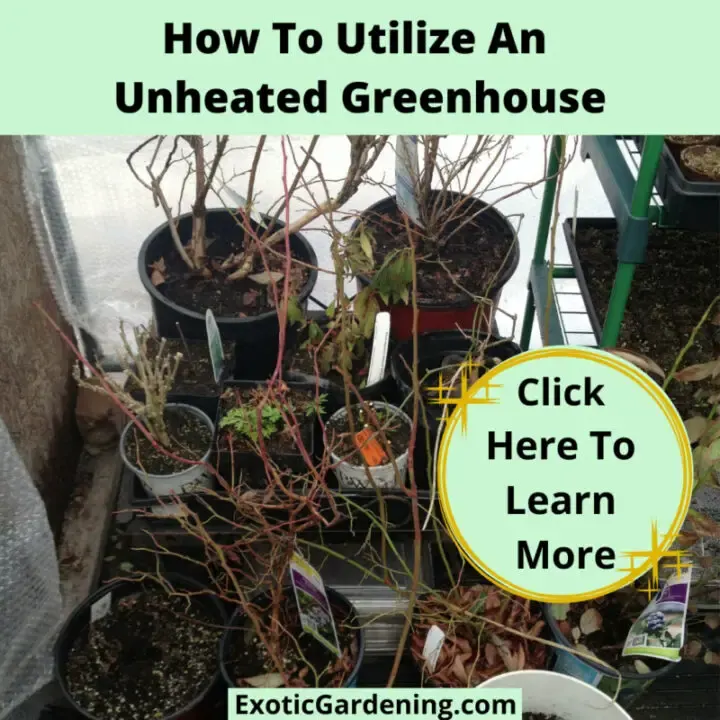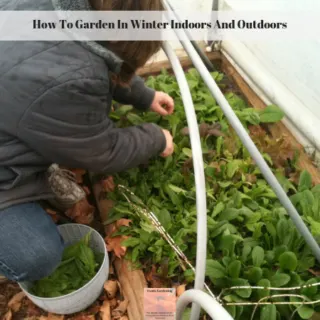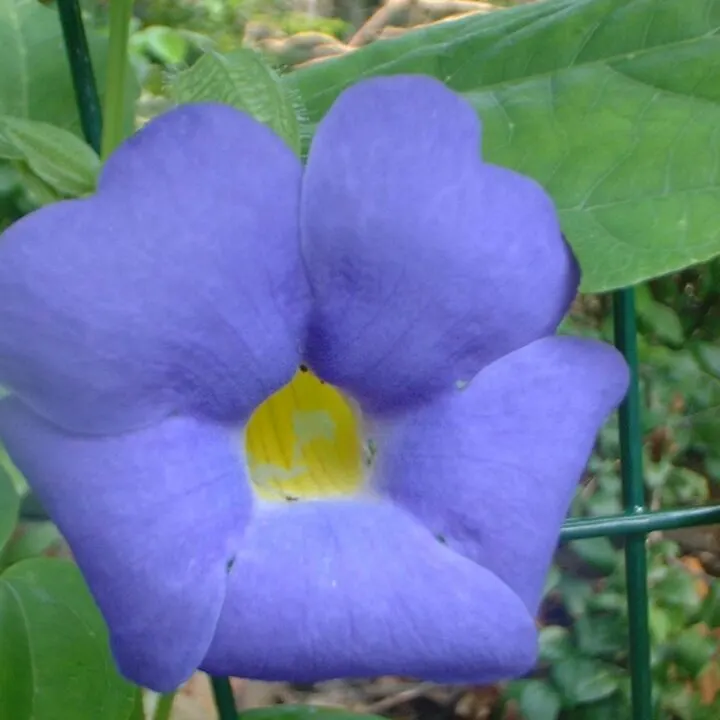The story of my tropical greenhouse September 2011 is one of resilience and renewal.
As many of you know, fall brought devastating destruction to my greenhouse and the vibrant collection of tropical plants I had cherished for years.
The heartbreak of seeing my hard work undone was immense.
While the large greenhouse remains in need of significant repairs to be fully functional again, my passion for gardening has driven me to press forward.
Slowly, I’ve begun rebuilding my collection and finding ways to adapt to these new circumstances.
In this post, I’ll take you on a journey through the remnants of my tropical treasures, sharing highlights from a YouTube video I created back in September 2011.
Together, we’ll explore the plants that survived, those I’ve started to nurture again, and the unexpected joy I’ve rediscovered along the way.
It’s a testament to nature’s resilience and the gardener’s determination.
Reviving My Greenhouse: The Move to a Smaller Space
In the aftermath of my greenhouse’s destruction, finding a way to protect and nurture my surviving plants became a top priority.
Without the large greenhouse to accommodate my collection, I relocated many of the plants that survived to a smaller, more manageable space.
While far from ideal, this smaller greenhouse has become a temporary sanctuary, allowing me to preserve what I could and slowly begin the process of rebuilding.
Though space is tight, every plant that continues to thrive is a reminder of the resilience of nature—and my own determination to start again.
One standout in this smaller collection is my beloved Heliconia.
Its vibrant foliage and dramatic flowers bring a burst of exotic beauty to the greenhouse.
This tropical treasure not only survived the upheaval but continues to flourish, reminding me why I fell in love with these plants in the first place.
Along with the Heliconia, I managed to save several roses, citrus trees, and hibiscus seedlings.
These delicate hibiscus seedlings, which I grew from seed, hold a special place in my heart.
Carefully potted up and tended to with care, they represent small but significant victories in restoring my collection.
Each bloom feels like a triumph, a tangible sign that rebuilding is possible, even in challenging circumstances.
Though the smaller greenhouse is only a temporary solution, it has become a symbol of resilience and hope.
It may lack the grandeur of my original space, but the life it holds is just as precious.
Every time I step inside, I’m reminded that even in the face of setbacks, growth is always possible.
Tropical Highlights and Treasured Finds
One of the greatest joys of gardening is the thrill of acquiring unique and extraordinary plants, each with its own story and charm.
Over the years, I’ve been fortunate to collect several treasures, including those from events like the Garden Writers Conference.
Among these special finds is a breathtaking Calla Lily from Terra Nova Nurseries called Edge of Night.
With its deep, dramatic blooms, this variety never fails to leave an impression and serves as a reminder of the beauty and diversity that tropical plants bring to a collection.
Another prized plant in my greenhouse is my Brunfelsia, lovingly grown from seed.
Known for its enchanting purple flowers and intoxicating fragrance, it’s a favorite that always draws admiration.
Watching it bloom is a small but meaningful triumph, especially considering the challenges I’ve faced in maintaining a tropical collection after the greenhouse disaster.
Yet, above all, my most cherished plant is the variegated Brugmansia.
Its striking trumpet-shaped flowers and intricate, patterned leaves make it the undeniable star of my collection.
Despite less-than-ideal growing conditions, this plant has persevered and thrived, symbolizing hope and determination during my journey of rebuilding.
Unfortunately, not all plants survived the devastation, and the loss of some of my rarest specimens still weighs heavily on my heart.
Among the most significant losses were my blooming Theobroma cacao trees, which brought the allure of growing chocolate right into my greenhouse.
I also lost my Cananga fruticosa (dwarf ylang-ylang), whose delicate, fragrant blooms were a constant delight, and my Syzygium aromaticum (clove tree), a rare treasure in any collection.
Other irreplaceable losses included several types of cinnamon trees, my Myristica fragrans (nutmeg tree), and a variety of ginger and heliconia plants.
Each of these represented not just beauty, but the incredible diversity of tropical flora that I had worked so hard to curate.
Though these losses are painful, they also inspire me to keep moving forward, rebuilding piece by piece, and holding on to the hope that one day, my collection will be whole again.
Overcoming Challenges in the Greenhouse
Adapting to the smaller greenhouse has come with its fair share of challenges, requiring a thoughtful approach to both space and plant care.
With significantly less room to work with, every square inch must be carefully planned and utilized.
Prioritizing which plants to save and where to place them has been a delicate balancing act, ensuring that each one receives the light, ventilation, and attention it needs to thrive.
Proper lighting has been especially crucial, as the smaller greenhouse doesn't allow for as much natural sunlight as my original space.
To compensate, I’ve set up full-spectrum grow lights to create an optimal growing environment.
Ventilation, too, has been a key focus, as stagnant air can quickly lead to issues like mold and mildew in such a confined area.
Maintaining airflow has required some creative problem-solving, including the use of small fans and strategic spacing between plants.
Being resourceful has become second nature.
Old planters have found new life, while shelving and hanging systems have helped me make the most of vertical space.
This has allowed me to accommodate a greater number of plants without overcrowding.
Every adjustment has been a learning experience, teaching me to adapt and innovate in ways I hadn’t anticipated.
One of my more unconventional experiments has been growing a tomato plant in an upside-down planter.
Initially, I was skeptical of this approach, but the results have been surprisingly positive.
The plant has not only survived but thrived, producing healthy growth and even fruit.
This unexpected success has been a testament to both the resilience of plants and the creativity required to keep them healthy in less-than-ideal conditions.
Despite the limitations, this smaller greenhouse has become a space of ingenuity and perseverance, proving that even under challenging circumstances, it’s possible to create something beautiful and functional.
Each challenge overcome feels like a victory, and I continue to learn and grow alongside my plants.
The Beauty of Jasmine and Other Aromatics
No greenhouse would be complete without the intoxicating scent of Jasmine, a delicate yet powerful plant that fills the air with its sweet, calming fragrance.
For me, Jasmine is more than just a plant; it’s a source of comfort and a reminder of the joy and serenity that gardening brings.
Its blossoms have a way of transforming even the smallest greenhouse into a tranquil escape, making it an essential part of my collection.
Aromatic plants like Jasmine add more than beauty—they create an atmosphere.
They invite you to pause, breathe deeply, and reconnect with nature.
This is why growing fragrant plants has always been such a cherished part of my gardening journey.
Alongside Jasmine, my collection once included the heavenly scent of Brugmansia, the delicate blooms of my dwarf ylang ylang, and the spicy, exotic aroma of fragrant gingers.
Each one added its own unique essence to the greenhouse, weaving together a tapestry of scents that turned the space into a sensory paradise.
One of my most enchanting plants was the Milky Way tree (Stemmadenia littoralis).
Its starry white flowers released a subtle, sweet fragrance that lingered in the air, making it a centerpiece of my collection.
I also treasured my scented geraniums, which, though unassuming, filled the greenhouse with their refreshing, herbal notes.
These plants brought not only beauty but also an emotional connection to my space, grounding me in the simple joys of gardening.
Losing so many of these treasured plants to freezing temperatures was heartbreaking.
It’s hard to describe the sadness of seeing such carefully nurtured specimens succumb in such a short time span.
Each one held memories and represented hours of care and dedication.
While some, like the Jasmine, have survived and continue to inspire me, others are irreplaceable, leaving a fragrant void that I feel deeply.
Even amidst the loss, the love for growing aromatic plants remains strong in my heart.
I hold onto the hope that I can one day restore this part of my collection, reintroducing these cherished scents to my greenhouse.
Until then, I’ll continue to nurture the Jasmine and the other survivors, finding solace in their beauty and the memories they evoke.
Future Plans for the Greenhouse
Looking ahead, my ultimate goal is to restore the large greenhouse to its former glory.
This space would allow me to expand my collection and recreate a thriving ecosystem for my tropical plants, something I’ve dreamed of for years.
The journey will require patience, resources, and effort, but the possibilities fill me with hope and excitement.
However, the road to restoration is deeply intertwined with a painful chapter in my life.
Fourteen years ago, during the cold snap that devastated my greenhouse, my then-husband and stepdad were present and could have saved some of the rare, irreplaceable plants I had carefully nurtured.
Unfortunately, they were upset because I had chosen to help a friend move that day and they had to deal with one another without me here to intervene.
Instead of stepping in to protect the plants, they did nothing, allowing them to freeze.
The loss was devastating, not only because of the plants but also because of the circumstances.
Even now, as both of them have passed away, the heartbreak remains.
The large greenhouse has never been replaced, and the rare specimens I lost that day—including many I may never find again—still linger in my thoughts.
Despite this, I am determined to move forward and focus on rebuilding, piece by piece, starting with the smaller greenhouse.
For now, I’ll continue nurturing the plants I’ve been able to save, experimenting with new techniques, and finding solace in the healing process that gardening provides.
Rebuilding has been both humbling and rewarding, reminding me of the resilience of nature and the power of determination.
While the scars of the past may never fully heal, the hope of creating something beautiful and vibrant again keeps me moving forward.
Tips for Starting and Maintaining a Tropical Greenhouse
Share Your Greenhouse Story
Have you faced challenges with your greenhouse or tropical plants?
I’d love to hear your experiences and tips!
Let’s create a community where we can inspire and support each other in our gardening journeys.
Restoring my tropical greenhouse has been a labor of love, filled with trials and triumphs.
Each plant I nurture back to health serves as a reminder that growth is always possible, even in the face of adversity.
I’m excited to continue sharing this journey with you and look forward to hearing about your own gardening adventures.
Greenhouses And Grow Lights
Dive into a collection of insightful articles designed to help you make the most of your greenhouse and grow light setup. Whether you’re a seasoned gardener or just starting, these blog posts cover everything you need to know to optimize plant growth year-round. From tips on maintaining your greenhouse to choosing the best grow lights for specific crops, this comprehensive list has something for everyone.
Learn about:
Seasonal greenhouse gardening techniques to keep your plants thriving, even in winter.
How to select, set up, and use grow lights effectively for indoor or greenhouse gardening.
Troubleshooting common greenhouse and lighting challenges, like temperature control and light intensity.
DIY projects and budget-friendly ideas to enhance your growing space.
Whether you’re growing food, flowers, or foliage, this collection of articles will inspire and empower you to create a productive and thriving growing environment. Let these resources guide you on your gardening journey!
5 Factors to Consider When Choosing Greenhouse Lighting
There are five factors that are important to consider when choosing greenhouse lighting. Learn what they are and why they are important.
Rare Tropical Plants in Greenhouse #1
Sometimes it's fun to share information on the plants you are growing, especially the rare tropical plants with others.
Cool Greenhouse Uses
Learn cool greenhouse uses for those of you that have a greenhouse but use passive solar heat or a small heater.
How To Utilize An Unheated Greenhouse
An unheated greenhouse is easy enough to utilize for a winter vegetable garden or even for winter seed starting.
Top 10 Tips for Making the Most of Your Unheated Greenhouse All Year Round
Discover how to make the most of your unheated greenhouse with these 10 tips for year-round gardening success.
How to Keep Your Unheated Greenhouse Productive: Winter Greenhouse Gardening Tips
Learn winter greenhouse gardening tips to keep your unheated greenhouse productive with crops, insulation, and microclimate tricks.
Dream Big: Revolutionize Your Garden with Year-Round Gardening in an Unheated Greenhouse
Discover the benefits and techniques of Year-Round Gardening in an Unheated Greenhouse for fresh, sustainable, and thriving winter crops.
Feeling Overwhelmed? Unheated Greenhouse Growing Made Simple for Beginners
Unheated greenhouse growing is simple and rewarding. Start small, experiment, and enjoy fresh winter harvests with these easy tips!
Preparing The Greenhouse For Winter
Learn about heating greenhouses in winter and preparing the greenhouse for winter so it is ready for winter greenhouse gardening.
Greenhouse And Cold Frame Garden Structure Ideas
Learn about tunnel houses, greenhouses and cold frame garden structures as well as how they are used to grow plants outdoors year round.
How To Garden In Winter Indoors And Outdoors
Learn how to garden in winter indoors and outdoors. There are many vegetables and herbs that don't mind the cold or thrive in containers.
Greenhouses And Season Extenders
Learn how greenhouses and season extenders help you grow fresh, healthy produce year-round, even in cold climates.
Just One More Greenhouse - Please
One more greenhouse means endless gardening possibilities! Discover tips and inspiration to expand your growing space effectively.
Garden #9 - The Greenhouse Garden
The greenhouse garden area consists of a large greenhouse that is divided into several sections.
These sections operate year-round and house a wide array of tropical plants.
